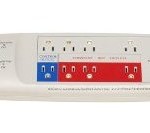Our MythTV entertainment system uses a decent amount of electricity. While watching TV, the television, DVD/Amplifier and computer (plus misc other items) use 335 watts of power. However, as we only average an hour or two of TV a day, this isn’t as large as the continuous power draw from the system when it is not in use. Even though we turn the TV and DVD/Amplifier off when not in use, the computer, HD Tuner, external HD, antenna preamplifier, printer, etc take up 141 watts when idle, and around 160 when recording, trans-coding, or detecting commercials in a television show. As the MythTV computer runs 24/7, this adds up to just over $10 a month of electricity (101 kW/h).
In an effort to save power, I have configured the MythTV system to shut itself off when idle, and wake up automatically five minutes before the next television show it is scheduled to record. This saves power, but has the major downside that the computer is not running and instantly ready whenever we want to watch TV. If the MythTV box isn’t already awake recording a show, you have to manually push the power button and then wait for two minutes while it boots up and gets itself ready. We are no longer able to press the TV-Power button and start watching TV five seconds later. However, this saves about 105 watts whenever the system is off (about 20-22 hours a day), or about $75-$84 a year.
We still have a constant drain of 36 watts, even when the system is turned off due to various peripherals and parasitic power drains.
- The UPS & Computer, even when turned off, takes 10 watts (Mostly the UPS keeping its battery charged).
- The external USB Hard Drive takes 8 watts.
- The printer takes 6 watts when in standby mode.
- The DVD/Amplifier, even when turned off (in standby mode) takes 5 watts of power.
- The HDTuner (Silicon Dust HDHomerun) takes 5 watts of power even when idle.
- Various other items (PDA charger, External Antenna pre-amp power injector, TV when off) take a watt each.
With the exception of the 10 watts from the UPS/Computer, the other power draws could be eliminated by using a “master-controlled” power-strip (such as the APC P7GT), which automatically turns off the controlled outlets when the computer (plugged into the master outlet) is turned off. This would save 26 watts whenever the computer was turned off, and would save about $20 worth of electricity in a year, paying for the fancy power saving power-strip in less than two years. Also, if I replaced the UPS with a “green” version, it would take less than 10 watts to keep the battery topped-up, but that cost savings would take longer to pay for itself.
